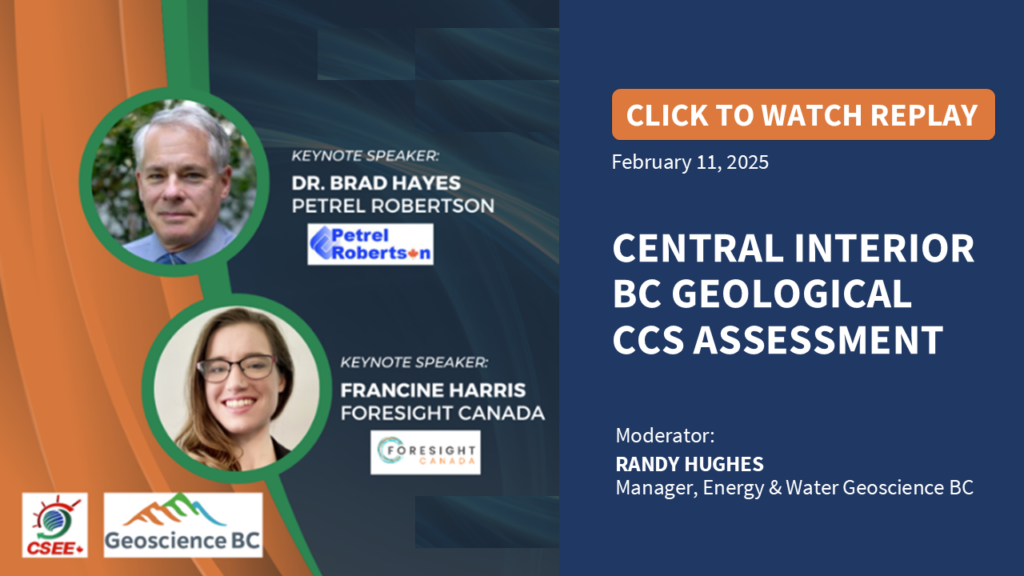The Need
BC hosts a range of rock formations and structures with the potential to sequester captured carbon dioxide. Understanding this potential is critical to understanding the role that CCS can play in BC and Canada’s transition to a net-zero emissions economy. A first step is to reinterpret existing data to provide a preliminary evaluation of carbon storage potential that can be used by industry, regulators, governments, communities, academia and Indigenous groups.
Project Goals
This Energy project fits under Geoscience BC’s Strategic Objective of ‘Enabling Clean Energy’.
Specifically, the goals for this project were to:
- Develop a consortium of industry partners to fund and participate in the geological carbon storage assessment of the Nechako Basin.
- Compile a reference list of past projects and published research studies.
- Provide mapping and shapefiles of the main geological carbon storage potential reservoir units for the Triassic, Jurassic, and Cretaceous zones.
- Provide mapping of primary faults and structural features.
- Publish an atlas-style report.
- Generate a preliminary assessment of CCS technical risks.
- Identify data gaps and recommendations for future research projects.
Project Benefits
As demonstrated by previous projects such as the Northeast BC Geological CSS Atlas, a publicly available atlas of carbon capture and storage potential in the Nechako Basin will be a key source of information for interested groups and an essential tool in the transition to a net-zero emissions economy.
Current emitters, such as in the energy and forestry sectors, and potential future emitters, such as a hydrogen generation industry, will benefit from an understanding of potential geological carbon storage options.
This foundational research could identify opportunities to diversify central and northern BC’s natural resource economies. The assessment can enable decision-making around the decarbonization of communities and industrial sectors, enhance the economic value and benefits of BC’s energy resources by increasing efficiency, create new opportunities for innovation and collaboration, and enable knowledge transfer and capacity building through the project’s collaborative approach.
Location
This desktop study covers the Nechako Basin, focusing south-southwest of Prince George.
Geoscience BC encourages anyone planning geological exploration work to first contact Indigenous groups in the area. The Province of British Columbia’s Consultative Areas Database can help with this (https://maps.gov.bc.ca/ess/hm/cadb/). The Association for Mineral Exploration (AME) also produces an Indigenous Engagement Guidebook.
What was Found?
The geological study of the Nechako Basin concludes that carbon storage opportunities within the Basin are limited, face considerable challenges, and are not technically recommended. Based on the limited data available, three areas approximately 75 kilometres northwest and west of Williams Lake have been identified as having limited potential for carbon storage but with geological risks such as needing a better assessment of the ability to inject CO2 into the identified zones, lack of well control and challenges interpreting geophysical data. A further five areas are recommended for consideration, including four areas approximately 100 kilometres west of Quesnel and one area approximately 50 kilometres south of Quesnel. To develop a better understanding of storage potential, new drilling in the Nechako Basin would be required.
Foresight Canada reviewed industrial emissions in and surrounding the basin, and opportunities for potential carbon capture and hub activities as a contribution to this project. It was found that at this time, challenges exist with respect to the scale, transportation distances and emissions compositions associated with emissions in the study area.
Although not studied in the current report, this central BC region might have potential for carbon dioxide to be permanently stored in shallow rocks through a process known as ‘carbon mineralization’ however this technology is not well developed. Further research is required to assess this storage potential in central BC. Geoscience BC has also supported carbon storage potential assessments in other locations in BC:

